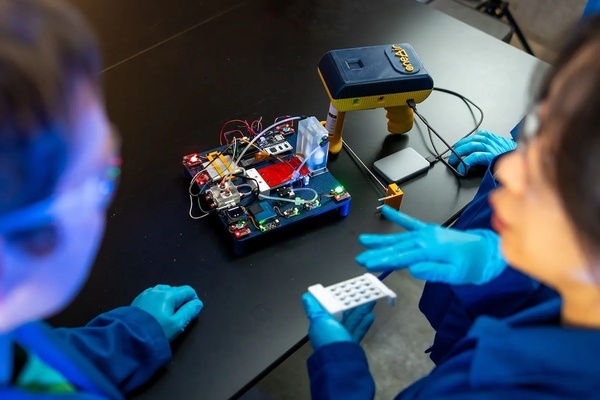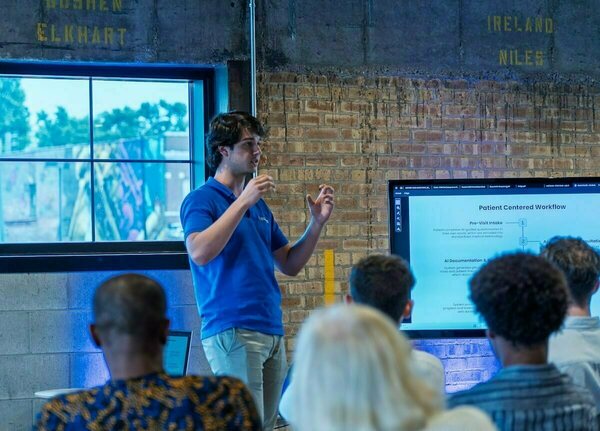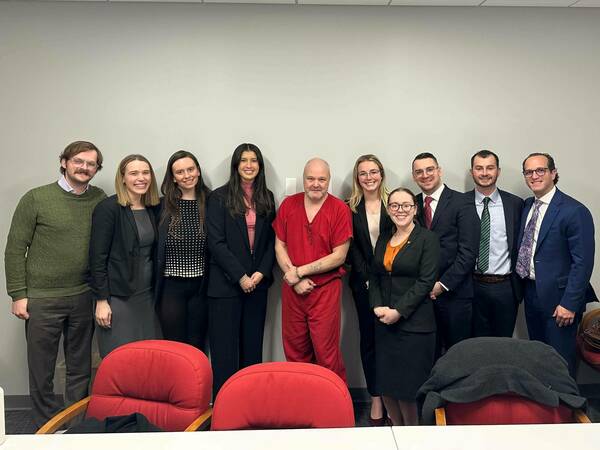Scissor-like Enzymes: Mehdi Alikhani’s research into matrix metalloproteinases (MMPs) and their practical implications
Like little scissors for our tissue, matrix metalloproteinases, or MMPs, are enzymes in our bodies that work to repair damaged tissue and aid in healing wounds.
Mehdi Alikhani, a postdoctoral researcher at the University of Notre Dame in the Department of Chemistry and Biochemistry, focuses on these MMPs. In Mayland Chang and Shahriar Mobashery’s lab, he looks at the role of MMPs in spinal-cord injuries, finding these enzymes in cerebrospinal fluid (CSF)–a clear liquid that protects and surrounds the spinal cord and brain.
MMPs are normally inactive in our bodies, only becoming active when they are needed. In fact, there is a certain type of protein called a tissue inhibitor, which can block the active site of the MMPs to ensure this.
However, in certain patients, like those with diabetes, the active MMPs outnumber the tissue inhibitors, which leads to the enzymes creating more damage than good. The Chang lab was able to manufacture a synthetic inhibitor specifically for diabetic patients that allows for their wounds to be properly healed.
Alikhani aims to identify and quantify active MMPs in CSF from humans, dogs with natural spinal cord injuries, and other animal models. He uses custom-made resins specifically designed to capture active MMPs coupled with advanced proteomics and spectrometry tools.
The work Alikhani does has additional practical uses, as his lab also works to create MMP inhibitors that prevent certain diseases or metastasis in cancer patients. The direct application of his work is one of the things Alikhani loves most about what he does.
“We can synthesize any compound we want, and from that, create a new drug. It’s very exciting to work in a lab where findings can be directly used in clinics,” said Alikhani.
Alikhani appreciates that his lab includes both biochemists and chemists, which opens up the breadth of the research that is possible. Because of this, Alikhani said, “We are much closer to a functional research lab than a basic one.”
In his previous positions, Alikhani would often have to send samples to off-site labs that had the proper specialized equipment to synthesize his compounds. Yet, Alikhani was drawn to Notre Dame for its robust chemistry and proteomics research facilities, which allows for everything to be done in-house.
In his free time, Alikhani enjoys attending the guest lectures and scientific talks that the College of Science hosts, particularly the ones that pertain to his department. “These scientists come from all over to share their research, and it’s really helpful to hear about their new ideas and discoveries,” Alikhani said.
Alikhani also appreciates taking walks around the campus. “The University is more beautiful than I could've even expected,” he said.
Being able to work in a lab where research directly translates into real-world solutions has been fulfilling for Alikhani, and he is excited to see the continued impact of the growing understanding of MMPs.
Originally published by at science.nd.edu on December 09, 2024.
Latest Research
- Fighting for Better Virus DetectionAn electronic nose developed by Notre Dame researchers is helping sniff out bird flu biomarkers for faster detection and fewer sick birds. Read the story
- Notre Dame’s seventh edition of Race to Revenue culminates in Demo Day, a celebration of student and alumni entrepreneurship…
- Managing director brings interdisciplinary background to Bioengineering & Life Sciences InitiativeThis story is part of a series of features highlighting the managing directors of the University's strategic initiatives. The managing directors are key (senior) staff members who work directly with the…
- Monsoon mechanics: civil engineers look for answers in the Bay of BengalOff the southwestern coast of India, a pool of unusually warm water forms, reaching 100 feet below the surface. Soon after, the air above begins to churn, triggering the summer monsoon season with its life-giving yet sometimes catastrophic rains. To better understand the link between the formation of the warm pool and the monsoon’s onset, five members of the University of Notre Dame’s Environmental Fluid Mechanics Laboratory set sail into the Bay of Bengal aboard the Thomas G. Thompson, a 274-foot vessel for oceanographic research.
- Exoneration Justice Clinic Victory: Jason Hubbell’s 1999 Murder Conviction Is VacatedThis past Friday, September 12, Bartholomew County Circuit Court Judge Kelly S. Benjamin entered an order vacating Exoneration Justice Clinic (EJC) client Jason Hubbell’s 1999 convictions for murder and criminal confinement based on the State of Indiana’s withholding of material exculpatory evidence implicating another man in the murder.
- Notre Dame to host summit on AI, faith and human flourishing, introducing new DELTA frameworkThe Institute for Ethics and the Common Good and the Notre Dame Ethics Initiative will host the Notre Dame Summit on AI, Faith and Human Flourishing on the University’s campus from Monday, Sept. 22 through Thursday, Sept. 25. This event will draw together a dynamic, ecumenical group of educators, faith leaders, technologists, journalists, policymakers and young people who believe in the enduring relevance of Christian ethical thought in a world of powerful AI.













